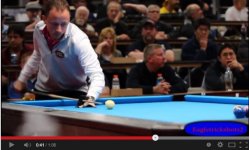Dudley,
You have WAY insufficient data to draw the conclusion you have. I'm not saying you're wrong, only that your conclusion is not necessarily true based on the data you have provided. I actually have a similar experience with the break speed app. My very fastest break ever resulted in the CB stopping dead about 6" from the rack with what appeared to be zero hop. I believe the explanation for this is that our best break speeds usually come from a dead center hit on the CB, where the least amount of energy is spent spinning the ball, and the force vector parallel to the table is proportionally the greatest (closest to 100% of the forward force). But I don't think anyone was arguing that the purpose for popping the rack was to achieve the greatest CB speed.
I believe it is also a baseless conclusion (not just on your part) that you should want to "impart the most energy into the rack as you can". If your sole objective is to log the fastest break speed, then sure. If on the other hand you are interested in pocketing a ball reliably, controlling the cue ball, and getting a consistently runable spread...I really don't think max energy into the rack is the way to go to achieve those results (unless as I said in a previous post you have a very weak break and struggle to hit 15 or 16 mph...in this case you might benefit from more energy).
I think a great test would be if we had video of say 10 of your breaks from the time you got your fastest speed. Of course we would have used a super high speed camera. We could slo-mo the contact with the rack, and see how much hop you get. We could then rate the results of the break on the important variables we choose (CB control, balls pocketed, quality of spread), and plot these things against amount of hop, or amount of speed, or both. If we had like 10,000 breaks from different people, ideally with the magic rack...perhaps then we are getting close to a "scientific" study, and at that point the claims all these people are making might have some actual weight.
I value your input to the conversation, please don't take this any other way. I wish everyone would post what their experiences are. I just don't think we as a group are very close at all to any definitive answers (all though some might disagree :wink

KMRUNOUT
